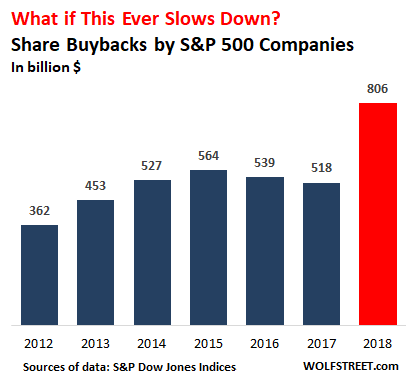What Would Stocks Do in “a World Without Buybacks,” Goldman Asks
Companies buying back their own shares has “consistently been the largest source of US equity demand.” Without them, “demand for shares would fall dramatically.” Too painful to even imagine.
Goldman Sachs asked a nerve-racking question and came up with an equally nerve-racking answer: What would happen to stocks “in a world without buybacks.” Because buybacks are a huge deal.
In the fourth quarter 2018, share repurchases soared 62.8% from a year earlier to a record $223 billion, beating the prior quarterly record set in the third quarter last year, of $204 billion, according to S&P Dow Jones Indices on March 25. It was the fourth quarterly record in a row, the longest such streak in the 20 years of the data. For the whole year 2018, share buybacks soared 55% year-over-year to a record $806 billion, beating the prior record of $589 billion set in 2007 by a blistering 37%!

Share buybacks had already peaked in 2015 and ticked down in 2016 and 2017. Then the tax reform act became effective on January 1, 2018, and share buybacks skyrocketed.
The record buybacks in Q4 came even as stock prices declined on average 5.3%, according to S&P Down Jones Indices. On some bad days during the quarter, corporations were about the only ones left buying their shares.
For the year 2018, these were the top super-duper buyback queens:
- Apple: $74.2 billion
- Oracle: $29.3 billion
- Wells Fargo $21.0 billion
- Microsoft: $16.3 billion
- Merck: $9.1 billion
But who, outside of corporations buying back their own shares, was buying shares? Goldman Sachs strategists answered this question in a report cited by Bloomberg, that used data from the Federal Reserve to determine “net US equity demand.” These are the largest investor categories other than corporate buybacks, five-year totals:
- Foreign investors shed $234 billion.
- Pension funds shed $901 billion, possibly to keep asset-class allocations on target as share prices soared.
- Stock mutual funds shed $217 billion.
- Life insurers added 61 billion
- Households added $223 billion.
…click on the above link to read the rest of the article…